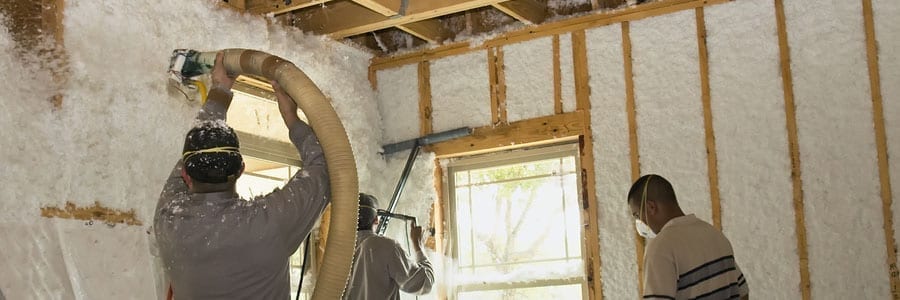A significant portion of a home’s heating and cooling costs results from air leakage through small gaps and holes. Spray foam insulation can reduce heating and cooling costs by plugging these small spaces.
According to the US Department of Energy, more than half of the energy cost of the average home goes into heating and cooling. Furthermore, 30% of the heating and cooling cost is the result of air infiltration. One of the newest advancements in home products, expanding spray foam insulation, can significantly reduce the amount of air leakage within a house.
Air leakage is often most noticeable during winter months. This is because it is during the winter that the maximum temperature difference exists between the warm interior and the cold exterior of a house. This maximum difference in temperature causes a large pressure discrepancy between a home’s inside and outside environments. In turn, this pressure discrepancy causes the warm inside air to be pushed through any small gaps to the cold laying outdoors. Therefore, these small gaps allow the heat which you paid to escape from your house.
Expanding spray foam insulation can plug these small holes. The spray foam insulation accomplishes this task by expanding into the small gaps onto which it has been sprayed.
However, to be effective it may be helpful to understand where these small holes may occur. One often thinks of the spaces near a door or window when thinking about the possible locations where currents may arise. However, there may be other locations that are not as apparent. These other locations are usually less apparent because they are found within the attic, basement, or crawlspace.
Indeed, almost any structure that acts as a passageway or opening can be a source of tiny currents. Besides the case of doors and windows, the Energy Star website provides a PDF file that lists eight places where air may leak from the warm interior of a home.
Holes used for wiring and pipes are examples of common locations through which currents may pass. The remaining six places associated with leakage include knee walls (a small wall usually under a meter in height), the access or doorway to the attic, recessed lighting and the box in which it is contained, the furnace flue, and the passageways containing air ducts and the boundary occurring between the home’s wood frames and foundation.
As mentioned earlier, spray foam insulation can fill small holes. However, care must be taken in its application. To be more specific, it should not be used in some of the areas listed above. For example, expanding spray foam insulation should not be used on doors or windows because it may damage these items as it expands. Additionally, it should not be used anywhere at which it is at risk of combusting. For example, it should not be used near the flue or near wiring.
Filling small holes and gaps reduces heating and cooling costs by lowering the amount of energy needed to heat and cool a home. Often this energy comes from sources that emit greenhouse gases. Therefore, as an additional benefit, preventing air leakage with spray foam insulation can help protect the environment.
When applied safely by a professional, spray foam insulation can substantially reduce heating and cooling costs, as well as to help protect the environment, by filling small gaps, holes, and cracks through which air may be exchanged between the interior and exterior of a home.

